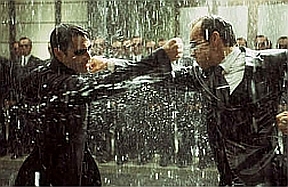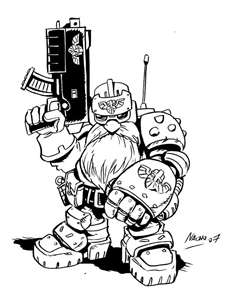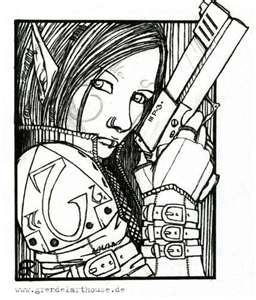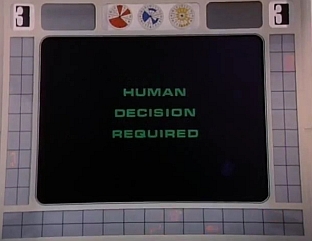“Make a Defense Check!”
 In Stars Without Number, the combat roll has a target number of 20+ on 1d20, subject to the following modifiers:
In Stars Without Number, the combat roll has a target number of 20+ on 1d20, subject to the following modifiers:
+ target’s Armor Class
+ attacker’s Combat skill
+ attacker’s attribute modifier
+ attacker’s Attack Bonus
That’s pretty simple, but I like for the players to make defense checks when their PCs are attacked. If I’m going to do this with SWN, I need to modify the combat roll.
A PC has a Defense Value equal to Armor Class (including Dexterity modifier). Thus, an unarmored PC with no Dexterity modifier has a +9 Defense Value. Armor adds to Defense Value an amount equal to 9 – the Armor Class provided by the armor. For example, a combat field uniform is Armor Class 4. It adds +5 to Defense Value.
Every enemy has an Attack Value equal to 19 plus (Combat skill + attribute modifier + and attack bonus). To make a defense check, the player rolls 1d20 + Defense Value. If the total equals or exceeds the enemy’s Attack Value, the PC’s defense succeeds. A natural 20 always succeeds, and a natural 1 always fails.
Consider the magovore invader versus a normal, unarmored human. This monster has a +6 attack bonus, which means it would have an Attack Value of 25. Using SWN core rules, the invader would need a 5 or better on 1d20 to hit the human (5 + 6 attack bonus + 9 Armor Class = 20 total combat roll). Using the defense roll, the human’s player needs a 16 or better on 1d20 (16 + 9 Defense Value = 25) to save his PC from the invader’s serrated beak.
Let’s consider a more complicated example. A PC with a 16 Dexterity is wearing combat field uniform (Armor Class 3) is fighting a level 3 warrior with a 14 Dexterity who is skill level 2 with Combat/Projectile Weapons. The PC’s Defense Value equals +15 (9 + 1 Dexterity + 4 armor). The enemy warrior’s Attack Value equals 23 (19 + 1 attack bonus + 1 Dexterity modifier + 2 Combat skill).
Using the normal combat roll, the enemy warrior would need a 13 or better to hit the PC (13 + 1 attack bonus + 3 Armor Class + 1 Dexterity modifier + 2 Combat skill = 20 total combat roll). Using the defense roll, the PC’s player needs an 8 or better on 1d20 (8 + 15 Defense Value = 23) to not get shot.
You might by this time be wondering, “Why do this?”
Good question, and I have what I think is a good answer. For a while now, I’ve wanted a way to introduce more narrative control into the standard RPGs. Narrative control shifts responsibility for describing game action from the GM to the players. I’ve experimented with a couple of ways to do this before, but they didn’t really seem to work (perhaps because I didn’t stick with them long enough).
I’m convinced that placing the burden for all attack rolls (and saving throws, but that’s another topic) on the players’ shoulders is key to giving the players more narrative control over the game. My recent readings here and there about Dungeon World (published by Sage Kobold Productions) have only further strengthened this conviction (but that too is a topic for another post).
 On Elanor, the Eugenics Commissars needed a durable race that could survive underground for long period of times. Gengineering resulted in the malgrandegulos, a stoic race famous for their love of both money and combat. Instability in the malgrandegulos genome has resulted in the speciation of a new race, the koboldo.*
On Elanor, the Eugenics Commissars needed a durable race that could survive underground for long period of times. Gengineering resulted in the malgrandegulos, a stoic race famous for their love of both money and combat. Instability in the malgrandegulos genome has resulted in the speciation of a new race, the koboldo.*
 In preparation for Tiamat’s Throne, I’ve been doing research into science fiction. Most recently, this has meant watching
In preparation for Tiamat’s Throne, I’ve been doing research into science fiction. Most recently, this has meant watching 